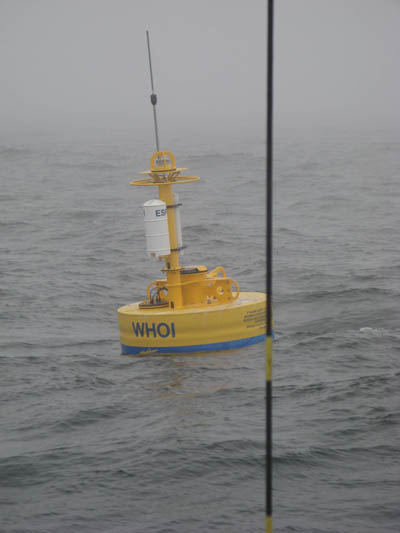ESPchris has not detected Alexandrium catenella since May 9 (detection limit is about 100 cells/L). Other Psuedo-nitzschia probes on the filter array have also not detected anything since deployment on May 2.
Ground truth samples (Alexandrium and nutrients) were collected at the buoy last week (May 23-25) on the R/V Tioga and indicated that no Alexandrium catenella cells were present based on live microscope counts. That result provided reassurance that ESPchris is still working properly despite the lack of detection during the last couple of weeks. Today's result is just in and again the filter array showed no detection.
Alexandrium and nutrient samples were also collected along 3 transects in the western Gulf of Maine to broaden the scope of the survey. Conditions were too difficult to examine samples at sea, but a few selected surface samples were examined upon return to port in the evening. The very preliminary results indicated that about 600 cells/L were present in northeast Casco Bay, while 160 cells/L were detected just offshore of the Bay. Few cells were observed in the more offshore surface waters. Similarly, surface samples near Cape Porpoise indicated that about 100 cells/L were present at the two stations located closest to the coast with few cells detected further offshore. The picture that emerges is a relatively low population (especially for this time of year) present in the western Maine coastal waters out to about the same distance offshore as ESPchris (5-6nm). So the instrument is well positioned to detect that population if it is transported further westward along the coast...of course the concentration of cells must remain above the detection limit of the instrument for ESPchris to report positive signals.
We do know that there are cells present to the south of the buoy within Mass Bay with shellfish toxicity reported there last Friday. To determine if cells were present at depth and possibly not sampled by ESPchris, samples were also collected at 1m, 10m, and 20m during the survey, but those results will not be available in the short term.
That's all for now...If we detect something, please know that you will be notified ASAP,
Bruce Keafer
PS I would like to thank Dave Townsend, Maura Thomas and Dave's student, Sugandha Shankar from UMaine for their stellar performance with the CTD and the collection of the nutrient samples needed for ground truthing the SUNA nutrient analyzer on the buoy. Inci Tuney, a postdoctoral investigator working with Kate Hubbard in the Anderson lab was heroic in fighting off 3 days of seasickness to obtain the Psuedo-nitzschia samples...and Jeff Stanwix, my Co-op student in the Anderson lab was solid during his first trip in the Gulf of Maine collecting the Alexandrium samples...and finally to Captain (Ken Houtler) and the mate of the R/V Tioga (WHOI) who go way beyond the norm to make the science at sea successful.


